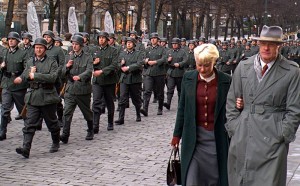2010‘s Royal Variety Show saw more stand-up comedians on the bill than anyone can remember. This, along with shows devoted to the genre on British TV, rising popularity of cruise ship entertainment and the growth of corporate comedy, confirms that solo comics working crowds with gag after gag, are ever popular.
Stand-up comedians, whether the natural clown in a classroom, at work or out for the night, or the jester who entertained the royal court in days gone by, telling people how foolish life is, are vital. Nonetheless, it’s a difficult performing art because everybody’s humour is unique.
Humour is not only personal, it varies regionally and nationally, is gender specific and dependent on numerous variables from crowd expectation to their boredom thresholds. It’s a wonder so many comics survive. Some do very well.
Advice to Stand-Ups
There are how-to books, comedy training clubs and courses to advise would-be comedians, ranging from detailed preparation, to ‘don’t do it’. They are urged to study the professionals, not to steal their jokes, of course, but to practise by reworking them, trying different build ups and punchline deliveries.
All comedians are observationalists; some adopt characters and topical issues. Others like Peter Kay and John Bishop are distinctly regional satirists; Lee Evans is a physical funster; improvisers include Paul Merton and Stephen Frost, while Ronni Ancona, Rory Bremner and Jon Culshaw are impressionists. All have found their own comic ‘voices’.
This includes the particular delivery style. Jack Dee is dead-pan, often wearing a pained expression, never cracking a smile himself. Performers are recommended to choose a persona that suits them naturally. That way, material comes from within, drawing on experience and idiosyncracies in equal measure. The ability to present oneself in a comic/ridiculous situation is almost as important as a burning desire to perform.
Things that worry people, make them angry or frightened are good sources of material. Going to the doctor or dentist, having a baby are everyday occurrences which can be funny in retrospect. Traffic wardens, estate agents and politicians are fair game as butts of humour. Everyday sufferings like traffic, shopping, animals and work are rich seams of comedy to be mined.
Relatives have traditionally been worth a laugh. Restaurants are frequently amusing; why people do things they do, often with little logic. Some think that ugliness, or even disability, are fertile grounds, too. Thalidomide, the Musical played in Britain in 2006, written by and starring Mat Fraser, himself a thalidomide victim.
Most comedy audiences have short attention spans, so build-ups must be brief. An exception is the shaggy-dog tale, as often told by Ronnie Corbett: a long-winded saga interspersed with dozens of one-liners, before a deliberately tame climax. Remembering jokes can be a challenge, so intense rehearsal is essential, like for any other performing art. Picking up on audience cues, singling individuals out often comes with experience, but is not always liked.
The Old School
Jonathan Brown, in a review in The Independent, May 2009 said: ‘Two hours into his show and Ken Dodd is taking a short break backstage. With a joke rate running at seven every 60 seconds, he has already told about 800 gags this evening – every one of which has raised a laugh or at least an indulgent groan from delighted fans’.
Brown pointed out: ‘By the time the capacity audience leaves the Palace Theatre in Mansfield shortly after midnight, five hours and 15 minutes after 80-year-old Dodd burst onto the stage banging a drum and singing Happiness, they have chuckled, sniggered or roared with laughter up to 2,000 times’. No modern performer can emulate that; ‘Doddy’ is unique.
Cornish comedian ‘Jethro’ (Geoff Rowe) was born in 1948 and worked his way up the comedy ladder from local pubs to TV to national tours with more TV, like most established comedians. His trademark is earthy, edgily ‘near the mark’ of acceptability jokes, rooted in his native area delivered in a rich accent.
Billy Connolly, Scottish observationalist; Bill Bailey, comic and musician; Harry Hill, intellectual-surrealism; Jim Davidson, London bloke into adult humour and Sean Lock, misleading ordinariness, all personify people who have made long careers out of the business of making people laugh by pointing out their absurdities.
Jo Brand used her experience working as a psychiatric nurse to launch stand-up, often of a feminist flavour. Victoria Wood is talented beyond stand-up as writer (Dinnerladies) and singer. Marcus Brigstocke is from the satirical background with a political edge.
Ben Elton, London born comic and left-wing activist is also author, playwright and TV director. He was big in 1980s’ ‘alternative comedy’, but also wrote cult TV shows like The Young Ones and Blackadder, and West End musical We Will Rock You (2002). Like Rowan Atkinson, Mel Smith, Pamela Anderson and Gryff Rhys Jones, he graduated from stand-up microphones to all-round amusing celebrity.
The New Guns
Michael McIntyre tops the list of new hot favourites (2010), who brings a well spoken, slightly camp, overweight and veering on politically incorrect humour, that sells out everywhere he goes. He also frequently hosts Live at the Apollo, a big TV stand-up show.
Kevin Bridges uses his Scottishness to make laughs; as Rob Brydon sometimes uses his Welshness. Sarah Millican uses relationship-disaster humour. Omid Djalili, born of Iranian parents cashes in on comedy about people in Iran, Iraq, Israel or anywhere ‘foreign’.
Iranian Shappi Khorsandi plays on a number of unique selling points – an Iranian woman working in Britain, tapping into the personal experiences of religion, culture and her divorce and disastrously trying to get back into the dating game. Miranda Hart plays on her taller, often awkward physical coordination to show how hard it is to get into the dating market in the first place.
The Controversial
Russell Brand carved a career from controversial comedy of the practical joke variety, which hasn’t stopped him being successful in film acting and TV presenting. Jimmy Carr combines dark humour with deadpan delivery, often pushing at audience-comfort boundaries. Scottish humourist Frankie Boyle deliberately generates morbid, often pessimistic joking, which has led to TV comedy success and losing it.
There is an argument that all comedy, especially stand-up, must be somewhat controversial. It was ever thus, from it’s Commedia dell’Arte origins to political comedy of today. What is certain, is that it’s serious big business making people laugh.
First published on Suite 101, 22 December 2010.
Photo: The Lonely Stand-Up Comic’s Spotlight – Kadellar
Read On
- Eastern Daily Press review of Thalidomide, the Musical Sept 2006 Web 21 Dec 2010.
- Making Fun of Parliament & Politicians: A Fine British Tradition
- Bringing Comedy to Audiences Is No Laughing Matter
- Physical Theatre: Commedia dell’Arte









